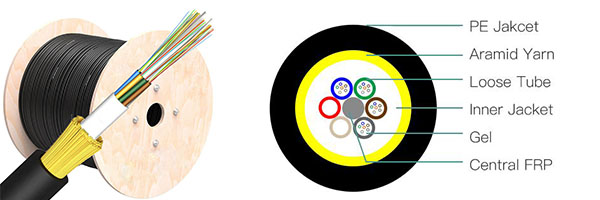What Is ADSS Cable?
ADSS cable is a type of fiber optic cable that is strong enough to support itself between structures without containing conductive metal elements. Both single mode and multimode fibers can be arranged in ADSS cables with a maximum of 144 fibers. ADSS fiber optic cable is designed for outside plant aerial and duct applications in local and campus network loop architectures from pole-to-building to town-to-town installations. The cabling system that includes cables, suspension, dead-end, and termination enclosures offers a comprehensive transmission circuit infrastructure with high-reliability performance.
The structure of ADSS cable can be divided into two categories—central tube structure and stranded structure. In a central tube design, the fibers are placed in a PBT loose tube filled with water-blocking material within a certain length. Then they are wrapped with aramid yarn according to the desired tensile strength and extruded with PE (≤110KV electric field strength) or AT (≥100KV electric field strength) sheath. This structure features with small diameter and light weight but has limited lengths.
In a stranded structure design, the inner optical fibers and water-blocking grease are added into the fiber loose tube, and different loose tubes are wound around the central reinforcement (usually FRP). The rest parts are basically similar to the central tube structure. This type is able to obtain longer fiber lengths. Although the diameter and weight are relatively big, ADSS cables with this structure are better to be deployed for large span applications.

What Are the Benefits of ADSS Cables?
When it comes to aerial cablings or outside plant (OSP) deployments, ADSS cable will provide an efficient and optimal solution in most of the cases. The remarkable advantages of this ADSS fiber cable are twofold: reliable and cost-effective.
Fundamentally speaking, ADSS fiber optic cable is small in size, light in weight, strong in structure, and flexible in applications, which is suitable for most outside aerial deployments. The small and light nature of the ADSS cable will reduce the load on tower structures for some external influencing factors like cable weight, wind, ice, etc. The structure design will not only prevent moisture and chemical attacks but also will protect the polymer strength elements from the effect of solar ultraviolet light. Besides, the strong structure will also allow up to 700m lengths to be installed between support towers.
Economically speaking, as an alternative to OPGW (Optical Fiber Ground Wire) and OPAC (Optical Attached Cable) solutions, ADSS cable can provide a cost-effective solution by saving the money and the resources with easier installment and wider ranges. Adopting ADSS cables can exploit the considerable economic advantages offered by the installation of existing high voltage power lines. In addition, the installation of ADSS cables is faster and easier than previous aerial designs. Do not need support or messenger wires, a single pass is sufficient for installation. ADSS cable can be used for applications ranging from short span (40-50 meter) distribution lines to long-span transmission lines (300-500 meter spans) to extraordinary spans required by some river canyon crossings exceeding 1,800 meters.
What Are the Applications of ADSS Cables?
Originally, ADSS cable was developed from a military lightweight rugged deployable (LRD) field cable. With the continuous improvements, it is now used for short span aerial installations—typically on roadside power distribution poles. Since the ADSS cable is non-metallic, it is ideal for applications near high-voltage power distribution lines for which it has become a standard. Using single mode fibers and light wavelengths of either 1310 nm or 1550 nm, circuits up to 100 km long are possible without repeaters. Usually, ADSS was used in 48 and 96 cores. Here is a sketch of a normal ADSS cabling scenario:
In addition, ADSS fiber cable is also suited to single-point suspension applications such as down mine shafts or any application where the product has to support either a higher load than conventional terrestrial cable or a permanent or varying tensile load that is applied through the outer sheath. What's more, ADSS can withstand the worst-case combinations of extreme weather, ice load, and wind environments, guaranteeing reliable communications in outdoor situations.
Conclusion
ADSS cable is ideal for installation in distribution as well as transmission environments. Since the ADSS cables provide an optimal solution for a broader combination of fiber counts and span lengths, more and more aerial cabling system designers tend to adopt them for telecommunications, like power utilities, telcos, and private network groups. Combining convenience and cost-effectiveness, an aerial fiber-optic deployment requires this kind of fiber optic cables for better performance.
04-08
202404-07
202403-26
202403-26
202403-18
202403-18
202403-13
202403-11
202403-11
202403-07
2024
